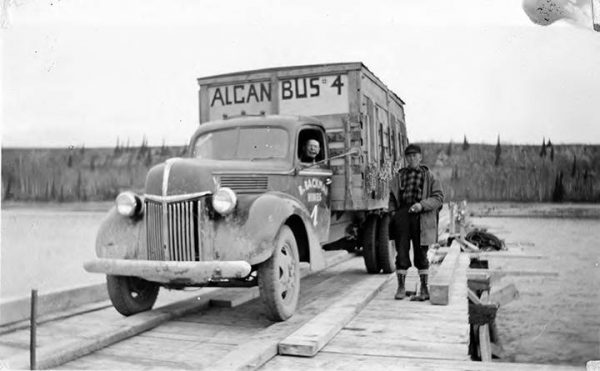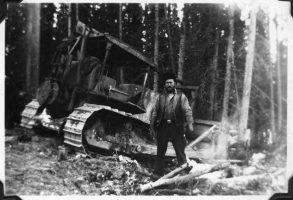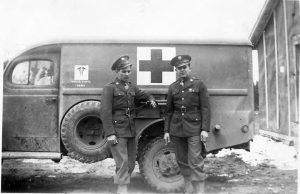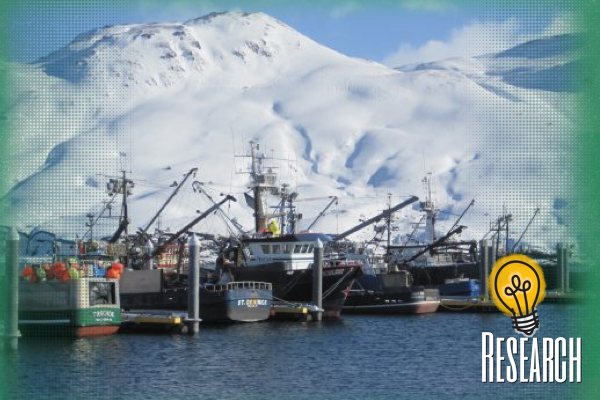Memory lane: The history of the Alaska Highway
by joey |

AlCan bus #4 on an unfinished bridge, from the collection of Thomas Saplak, a U.S. Army soldier with Company G of the 477th. (Thomas Saplak photographs, Archives and Special Collections, Consortium Library, University of Alaska Anchorage)
Driving the massive, gritty Alaska Highway is an adventure that requires preparation, dedication and time.
Now imagine what it felt like to build it.
This year marks the 75th anniversary of the highway's completion. From March to October 1942, an estimated 10,000 service members worked through sweltering days and frigid nights to build an incredible 1,400 miles of highway in only eight months. And of those 10,000-engineers, grunts, medics, cooks, electricians, and more-several now have their memories and photos from the project stored at Archives and Special Collections at the UAA/APU Consortium Library.
Mile 0

Thomas Saplak and the 477th worked on the southern legs of the highway in British Columbia. (Thomas Saplak photographs, Archives and Special Collections, Consortium Library, University of Alaska Anchorage)
This story starts, of course, at Mile 0, in the small farm town of Dawson Creek, British Columbia.
"The rural quiet was shattered one subzero morning in March 1942 when the first troops arrived," wrote Jerome Sheldon, a member of the 18th Engineer Regiment who would later become news editor of the Fairbanks Daily News-Miner. (His papers are now part of Archives and Special Collections.)
For years, folks in Washington D.C. entertained the idea of a highway connecting Alaska to the Lower 48. The bombing of Pearl Harbor spurred those conversations into action.

A man stands before a broken down bulldozer in the dense forest along the highway's path. (Lyle Sherman Leseberg photograph albums, Alaska Historical Society collections, Archives and Special Collections, Consortium Library, University of Alaska Anchorage)
After quick negotiations with Canada, President Franklin D. Roosevelt authorized the highway in February 1942. The road would provide supplies to American troops in the North, and safeguard a string of North American airfields that dispatched planes to Russian allies.
Soldiers arrived weeks later, armed with battle equipment in case the Japanese gained a foothold in Alaska. Many came from the Southern U.S., encountering snow, moose and subzero cold snaps for the first time.
"Well the boys are finally getting used to the idea of bears," wrote Donald F. Culver on a birch bark letter mailed to his mother in June 1942 (the letter is now part of Culver's collection in the Archives.)

Ferrying a truck across the Hyland River in Yukon Territory. (Albert Weir photographs, Archives and Special Collections, Consortium Library, University of Alaska Anchorage)
The initial months were a race against nature, moving as many supplies as possible over frozen ground. Sheldon wrote of soldiers camping in decaying gold rush buildings and sleeping on saloon floors on the way to Whitehorse. As the land thawed, barges brought supplies up the Teslin Rivers and teams built timber bridges over massive lakes, wading into frigid waters to stabilize supports. Japan's June bombing of Dutch Harbor and occupation of Attu and Kiska quickened the project's pace. A single road was all that mattered, even if looked like a wide hiking path in places, even if it required dangerous switchbacks that would never pass muster today.
On Oct. 25, 1942, Corp. Refines Sims Jr. of the 97th Engineers and Private Alfred Jalufka of the 18th nearly careened into each other in the dense spruce forest near Beaver Creek, Yukon Territory. They parked their bulldozers and met in the middle, shaking hands over the last gap in the clear-cut path. Postcards memorializing the moment are included in the Jerome Sheldon papers.
The celebratory photo shows the first steps in desegregating the military. Four of the seven regiments stationed to the highway were white, while the other three were black units led by white commanders and often given second-tier equipment. The effort and dedication of the 93rd, 95th and 97th Engineers defied the military's impressions that black regiments were any less committed and capable than white regiments. Though the highway cleared a path to Alaska, historians also credit the project for paving a road to civil rights. President Harry S. Truman desegregated the military six years later.

Refines Sims Jr., left, and Pvt. Alfred Jalufka connected the final stretch of the highway on Oct. 25, 1942. (Photo by Army Corps of Engineers, public domain)
Transportation contemplation
With the road complete, soldiers dispatched to urgent wartime projects from Shemya to Sicily.

Andy Badner and Thomas Seplak in front of an Army medic van along the Alaska Highway. (Thomas Saplak photographs, Archives and Special Collections, Consortium Library, University of Alaska Anchorage)
Civilians arrived in 1943 to make improvements on the highway, including contractor Florentine Traxler and electrician Bud Krier. In 1945, former Navy Seabee John Andrew Higgins arrived in Whitehorse to manage a supply center. All three have scrapbooks, photographs, poems and more at Archives and Special Collections as well.
In 1963, Col. E.G . Paules, formerly of the 18th Engineers, returned to the highway to reminisce on his thousands of brothers, tackling an immense goal on military wages. (His writing is included in the Jerome Sheldon papers.)

A man stands in front of a convoy on the Alaska Highway. (Albert Weir photographs, Archives and Special Collections, Consortium Library, University of Alaska Anchorage)
"As I stopped here and there along the Fairbanks Whitehorse Road, I looked at the remnants of our old bridges and recalled the cold, the heat, the mosquitoes," he wrote. "There in memory, I again saw men working in the Spring thaws, later in the summer sun that sometimes went as high as 90° and amid swarms of mosquitoes and 'no see 'ems', and toward the end, of the sub zero weather of the worst winter in the Yukon in 20 years. Living in tents with the thermometer in one 4-day cold spell going as low as 72° below zero at night. I could picture the urgency of the job, the pressure, and the other numerous hardships."
Today, the highway remains the ultimate North American road trip. Thousands of RVs and hatchbacks ply the road each summer and, just this month, Canada connected the road all the way to the Arctic Ocean with a gravel spur to Tuktoyaktuk.
But Jerome Sheldon summed up the highway's post-war impact best in a freelance story from 1963:
"Ohio license plates," he wrote, "are not an uncommon sight in Fairbanks."

Take it from these Ohio-based gallivanting grandmas... the Alaska Highway remains an adventure today. (Jerome Sheldon papers, Archives and Special Collections, Consortium Library, University of Alaska Anchorage)
See images of the highway online via Alaska's Digital Archives.
Written by J. Besl, UAA Office of University Advancement
Archives and Special Collections at the UAA/APU Consortium Library holds a dozen collections on the Alaska Highway. The following are included in this story:
Donald F. Culver papers, Archives and Special Collections, Consortium Library, University of Alaska Anchorage.
John Andrew Higgins papers, Archives and Special Collections, Consortium Library, University of Alaska Anchorage.
Bud Krier papers, Archives and Special Collections, Consortium Library, University of Alaska Anchorage.
Lyle Sherman Leseberg photograph albums, Alaska Historical Society collections, Archives and Special Collections, Consortium Library, University of Alaska Anchorage.
Thomas Saplak photographs, Archives and Special Collections, Consortium Library, University of Alaska Anchorage.
Jerome Sheldon papers, Archives and Special Collections, Consortium Library, University of Alaska Anchorage.
Florentine A. Traxler papers, Archives and Special Collections, Consortium Library, University of Alaska Anchorage.
Albert Weir photographs, Archives and Special Collections, Consortium Library, University of Alaska Anchorage.
 "Memory lane: The history of the Alaska Highway" is licensed under a Creative Commons Attribution-NonCommercial 4.0 International License.
"Memory lane: The history of the Alaska Highway" is licensed under a Creative Commons Attribution-NonCommercial 4.0 International License.














